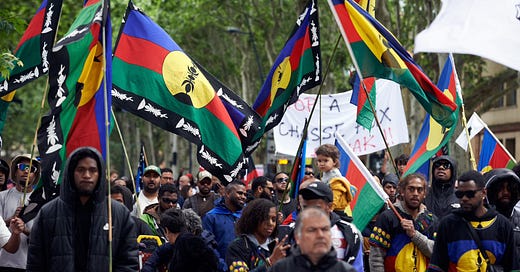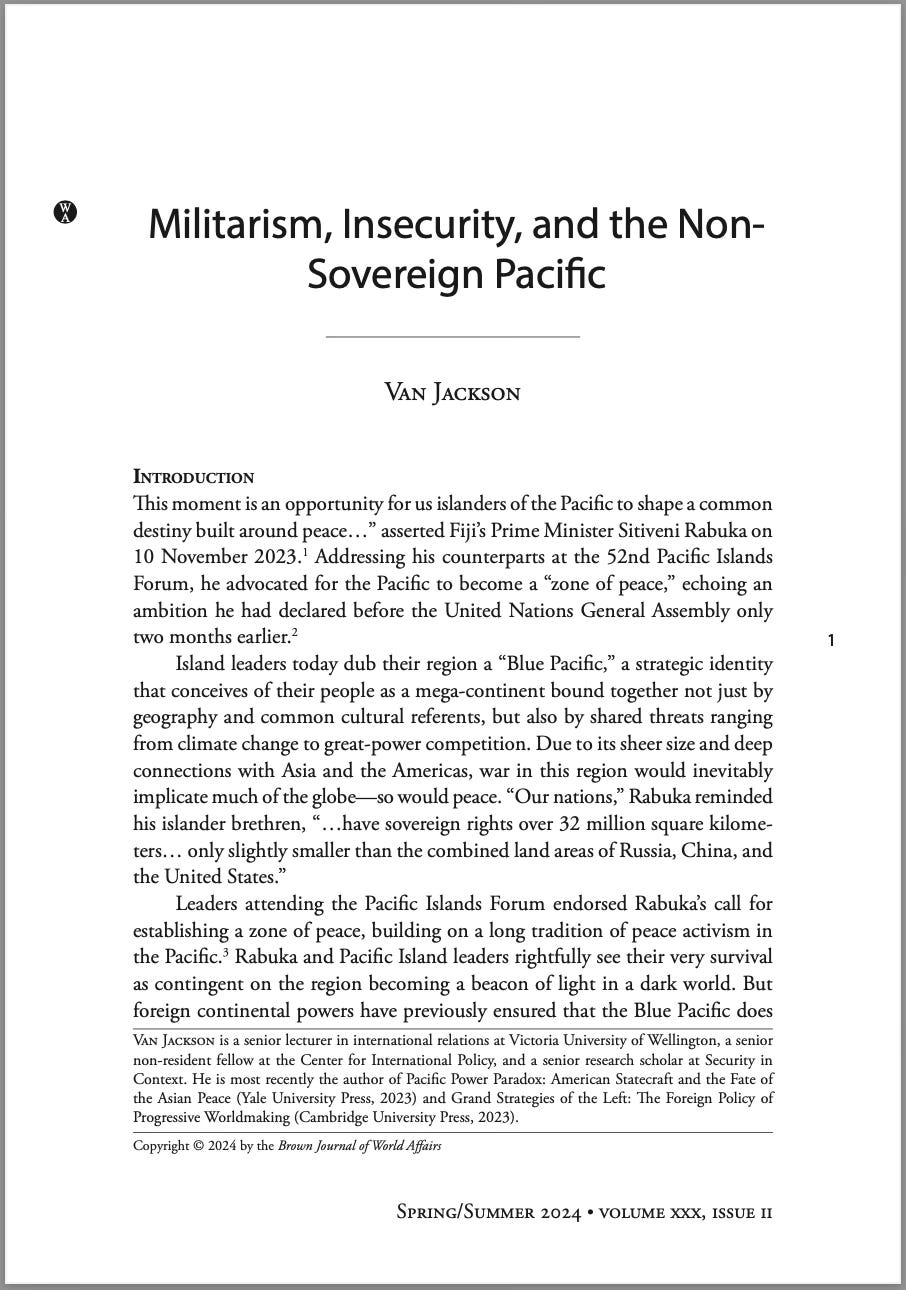The Non-Sovereign Pacific: What You Should Know
A large section of the Pacific region is functionally or formally non-sovereign. It’s a feature--not a bug--in great-power foreign policy. It’s also a root cause of insecurity for all of us.
I’ve been writing and thinking a lot about the Pacific in recent years. Learning about the region on its own terms has helped me see geopolitics differently. The region’s insecurity—in multiple senses—is bound up with larger “strategic” security problems that emanate from outside powers (disproportionately the US and China).
The latest culmination of all this work is a new article I have in the Brown Journal of World Affairs. It’s called “Militarism, Insecurity, and the Non-Sovereign Pacific.” During my 2023 trip to Fiji, my buddy Ken Kuper was the first person I ever heard use the term “Non-Sovereign Pacific.” It’s an analytical category that doesn’t exist until we speak it into being. It conceptualizes a section of the Pacific Islands region as a political bloc that gets erased from seemingly every conversation, whether intentionally or not. And that erasure has consequences.
As I argue in the article—the introduction to which is included below—denying multiple nations sovereignty (or in some cases autonomy) is a major source of the region’s strategic troubles. I may develop this into a larger project, but for now, enjoy these 6k words. The upshot is this:
The only credible buffer against the predations of outside powers is a truly Independent Pacific capable of functioning as a cohesive regional power bloc;
An Independent Pacific is not possible as long as a Non-Sovereign Pacific resides within it;
The great powers are MORE strategically vulnerable to each other as long as the Pacific is incapable of functioning as a strategic buffer between them; and
Great powers that are less secure because of the Pacific’s hierarchical relations act in ways that make one another and everyone else less secure; and
All of this means that justice and security are causally related. A geopolitics that brackets off moral questions—or confuses power with virtue—is self-defeating at best.
Read on!
Introduction
“This moment is an opportunity for us islanders of the Pacific to shape a common destiny built around peace…” asserted Fiji’s Prime Minister Sitiveni Rabuka on 10 November 2023.1
Addressing his counterparts at the 52nd Pacific Islands Forum, he advocated for the Pacific to become a “zone of peace,” echoing an ambition he had declared before the United Nations General Assembly only two months earlier. Island leaders today dub their region a “Blue Pacific,” a strategic identity that conceives of their people as a mega-continent bound together not just by geography and common cultural referents, but also by shared threats ranging from climate change to great-power competition.
Due to its sheer size and deep connections with Asia and the Americas, war in this region would inevitably implicate much of the globe—so would peace. “Our nations,” Rabuka reminded his islander brethren, “…have sovereign rights over 32 million square kilometers…only slightly smaller than the combined land areas of Russia, China, and the United States.” Leaders attending the Pacific Islands Forum endorsed Rabuka’s call for establishing a zone of peace, building on a long tradition of peace activism in the Pacific.2
Rabuka and Pacific Island leaders rightfully see their very survival as contingent on the region becoming a beacon of light in a dark world. But foreign continental powers have previously ensured that the Blue Pacific does not act as the expansive, unified, strategically vital site that it must be in order to foster peace. The geopolitical circumstances facing the Pacific directly threaten Rabuka’s vision.
This essay argues that the security-first fixation driving the continental powers’ engagement with the Pacific makes the region both less secure and more vulnerable to outside predation. Contrary to Western rhetorical visions of a “free, open, and inclusive Indo-Pacific,”3 a large area of the Blue Pacific region does not even exercise national sovereignty.
This Non-Sovereign Pacific—which includes Guam, the Commonwealth of the Northern Mariana Islands (CNMI), American Samoa, New Caledonia, French Polynesia, and the semi-sovereign “freely associated” states of Palau, the Marshall Islands, and the Federated States of Micronesia—is a reality reproduced and exploited by great-power rivalry.4 The securitizing gaze of outside powers leads them to conclude that they must exercise exclusionary control—rhetorically referred to as “influence” or “strategic denial” —over the Blue Pacific.
China sees the region as a place to dump excess productive output and surplus labor. As China’s presence expands, so does its interest in ensuring the security of its people and businesses there. The United States sees the Pacific as a litmus test of its global primacy and a sacrifice zone—that is, a site for redirecting enemy violence away from the U.S. homeland and toward foreign territory it controls.
Both China and the United States would like the Pacific to remain a buffer between them—a shock absorber blunting any projection of military force—but paradoxically proceed as if only domination, a zero-sum influence, can preserve this strategic buffer.
These perspectives lead to security-first engagement with the Pacific, which consists of militarizing the region and subordinating everything from development aid to climate adaptation to geopolitical games that tend to benefit “great” powers at the expense of smaller ones. This type of engagement also preserves the Non-Sovereign Pacific’s colonial dependencies in amber, which is neither an oversight nor a historical-legal quirk but rather an imposition of international hierarchy.
The irony is that the creation of spheres of influence engenders greater insecurity for the region as a whole—a total subversion of the Pacific’s longstanding peace ambitions. It is impossible for an ununified Pacific comprised of patchwork political statuses and imperialistic relations to exercise sovereignty collectively. By subordinating the Pacific’s independence to geopolitical concerns, continentally based powers—primarily the United States, but also China, Australia, and France—ensure that the Blue Pacific cannot act as the expansive, unified, strategically vital site that would allow it to secure not only itself from the major powers but also the great powers from one another.
But this ironic insecurity does not have to persist. The United States, China, and more minor powers like Australia will find no better security source than a unified, strategically autonomous Blue Pacific region…
Read the Rest:
Get the PDF
Citation: Van Jackson, “Militarism, Insecurity, and the Non-Sovereign Pacific,” Brown Journal of World Affairs Vol. 30, no. 2 (2024), pp. 1-15.
“Pacific Islands Forum Leaders Embrace Fiji’s Vision for a ‘Zone of Peace,’” Office of the Prime Minister Press Release, November 10, 2023, http://www.pmoffice.gov.fj/pacific-islands-forum-leaders-embrace-fijis-vision-for-a-zone-of-peace-10-11-23/.
“The People’s Charter for a Nuclear Free and Independent Pacific”, Nuclear Free and Independent Pacific Movement Conference, 1983, http://www.apc.org.nz/pma/pacchar.htm; Marco de Jong, “’Our Pacific Through Native Eyes’: Māori Activism in the Nuclear Free and Independent Pacific Movement, 1980–5,” Journal of Pacific History (2023), https://www.tandfonline.com/doi/full/10.1080/00223344.2023.2280265.
“Free, open, and inclusive” is the Biden administration’s description of its Indo-Pacific strategy, which is an equally hypocritical rephrasing of the Trump administration’s “free and open Indo-Pacific” vision. On this phrase and their distinctions, see Van Jackson, Pacific Power Paradox: American Statecraft and the Fate of the Asian Peace (New Haven: Yale University Press, 2023), 164-96, 208-10.
The Non-Sovereign Pacific arguably encompasses more than these nations, including West Papua, Bougainville, and the native Hawaiian independence movement, as well as Niue, Rapanui, Tokelau, the Pitcairn Islands, and in some respects the Cook Islands and Kiribati. Any national grouping that lacks control of its own political affairs or “national security” choices is not fully sovereign. But for purposes here, I am primarily concerned with the intersection of 1) nations denied both self-government and assimilation and 2) nations actively exploited for politico-military purposes. “Freely associated” states are semi-sovereign.





